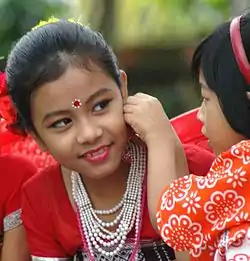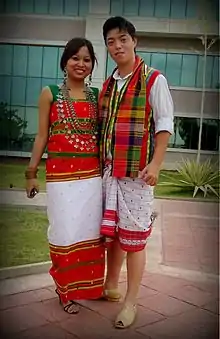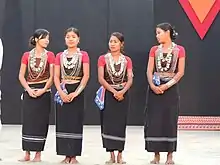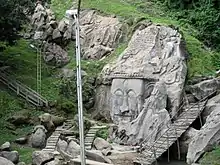Culture of Tripura
Culture of Tripura is distinct and a bit similar to other people of Northeast India. However like Assam, Manipur, Burma and Southeast Asia culture of Tripura is characterized in small portion living in plain areas notably the Tripuri culture. Tripura is a state in North East India. In the 2001 census of India, Bengalis represented almost 70% of the population and the Tripuri population comprised 30% of Tripura's population. The Tripuri population (indigenous population) comprises some clans and ethnic groups with diverse languages and cultures. The largest native group was the Tripuri who had a population of 543,848 in 2001 census,[1] representing 16.99% of the state population and 54.7% of the scheduled tribe population.[1] The other group of people in order of decreasing population were Chakma (6.5%), Halam (4.8%), Mog (3.1%), Munda, Kuki tribes and Garo Hajong.[1] Bengali is the most spoken language, due to the dominance of Bengali people in the state. Kokborok (Tripuri/Tiprakok) is a common language among Tripuris and lingua franca among tribes. Several other languages belonging to Indo-European and Sino-Tibetan families are spoken by the different tribe



Tripura has several diverse ethno-linguistic groups, which has given rise to a composite culture. The dominant cultures are Tripuris who are: Tripuris, Jamatia, Reang, Tripura, Naitong, Koloi, Murasing, Rupini Uchoi, and tribes like Chakma, Halam, Garo, Hajong, Kuki, Mizo, Mogh, Munda, Oraon, Santhal
Tripuri Traditional Attire
Tripuris have their own traditional dress, similar in style to that of other North-East Indian peoples. It is, however, different in pattern and design. The clothing for the lower half of the body is called rignai in Tripuri and for the upper half of the body, the clothing has two parts, the risa and rikutu.
Isree(Qeen) Monmohini Devi in Traditional Risa The risa covers the chest area and the rikutu covers the whole of the upper half of the body. Formerly, these garments were woven by women using home-spun cotton thread. Nowadays, the threads are bought from the market and the risa is not worn; instead a blouse is worn by most Tripuri women. Girls wear rignai with tops, too. Each Tripuri clan has its own rignai pattern and design. The patterns of the rignai are so distinct that the clan of a Tripuri woman can be identified by the pattern of her rignai. However, there is intermingling of the rignai: Clans wear the rignai of other clans freely and new designs are being woven. The rikutu is plain cloth of a different colour and shade than the other items of clothing. Today, the rikutu is woven by Tripuri women.
A young Tripuri woman wearing rigwnai and risa Some fashion types that are woven in the rignai borok by Tripuri women are as follows: Anji Banarosi Chamthwibar Jirabi Khamjang Khumbar Kuaiphang Kuaichu Kuaichu bokobom Kuaichu ulta Malibar Miyong Muikhunchok Monaisora Muisili Natupalia Phantokbar Sada Salu Similik yapai Takhumtei Temanlia Thaimaikrang Thaiphlokbar Tokbakbar Tokha Toksa Toiling Toprengsakhitung Rignaichamwthwi Rignai mereng Metereng trang Rignai khamchwi Kwsakwpra Rignaibru Rignaikosong Kwsapra Songkai Sorbangi It is said that at the time of Subrai Raja, the most famous and legendary King of Tripura, through his 250 wives he had invented 250 designs of rignai. He married those women who invented a new design. But all these designs have been lost over time and only a few remain. An effort to rediscover the lost designs is in process. The male counterpart for the loin area is rikutu and for the upper part of the body is the kamchwlwi borok. Today, however, very few men wear this style of dress except in rural Tripura and by the working class. Males have adopted more modern dres
Handicrafts
Tripura is noted for bamboo and cane handicrafts.[2] Bamboo played important part in the jhumia (shifting cultivation) of the tribes. It was used to make watch stations on stilts and was devised to carry food and water. Besides these usages, bamboo, woods and cane were used to create an array of furniture, utensils, hand-held fans, replicas, mats, baskets, idols and interior decoration materials.[3][4]
Songs and dances

Music and dances are integral part of the tribal people of Tripura. Some of their indigenous musical instruments are the sarinda, chongpreng, and sumui (a kind of flute). Songs are sung during religious occasions, weddings, and other festivals. Each tribal community has their own repertoire of songs and dances. The Tripuri and Jamatia tribe perform goria dance during the Goria puja. Jhum dance (also called tangbiti dance) in the harvest season, lebang dance, mamita dance, and mosak sulmani dance are other Tripuri dances.[5] Reang community, the second largest tribe of the state, are noted for their hojagiri dance performed by young girls balancing on earthen pitchers.[5] The Bizhu dance is performed by the Chakmas during the Bizhu festival (the last day of the month of Chaitra). Other tribal dances are wangala dance of the Garo people, hai-hak dance of the Halam branch of Kuki people, sangrai dance and owa dance of the Mog tribe, and others.[5] Besides tribal music, Indian classical music is also practiced among the residents. Sachin Dev Burman of the royal family was a maestro in the filmi genre of Indian music, creating many popular tunes in the bollywood films.
Festivals and worships
Hindus believe that Tripureshwari is the patron goddess of Tripura and an aspect of Shakti. Several fertility gods are also worshiped by the tribes, such as Lam-Pra (the twin deities of sky and sea), Mailu-ma (goddess of corn, identified with Lakshmi), Khulu-ma (goddess of the cotton plant), and Burha-sa (god of healing). Durga Puja, Kali Puja, Ashokastami and the worship of the Chaturdasha deities are important festivals. Several festivals represent confluence of several tribal traditions, such as Ganga puja, Garia puja, Kherchi puja, Ker puja.[6][7]
Sculpture and architecture

Unakoti, Pilak, and Devtamura are historic sites where large collections of stone carvings and rock sculptures are noted.[2][8] These sculptures are evidence of the presence of Buddhism and Brahmanical orders for centuries. These sculptures represent a rare artistic fusion of traditional religions and tribal influence.[9][10][11]
Sports
Football and cricket are the most popular sports in the state. The state capital Agartala has its own club football championships every year where many local clubs compete in a league and knockout format. Tripura participates as an eastern state team in the Ranji Trophy, the Indian domestic cricket competition. The state also is a regular participant of the Indian National Games and the North Eastern Games. Tripura produced a few nationally successful players in gymnastics and swimming, but overall contribution in athletics, cricket, football and indoor games remained poor.[12]
References
- "Tripura data highlights: the scheduled tribes" (PDF). Registrar General & Census Commissioner, India. Retrieved 20 April 2012.
- Chaudhury, Saroj (2009). "Tripura: a composite culture" (PDF). Glimpses from the North-East. National Knowledge Commission. pp. 55–61. Archived from the original (PDF) on 11 September 2010. Retrieved 5 July 2012.
- "Handicrafts". Government of Tripura. Archived from the original on 10 April 2012. Retrieved 7 July 2012.
- Chakraborty, Kiran Sankar (2006). Entrepreneurship and small business development: with special reference to Tripura. Mittal Publications. pp. 39–41. ISBN 9788183241250.
- "The folk dance and music of Tripura" (PDF). Tripura Tribal Areas Autonomous District Council. Archived from the original (PDF) on 2 April 2013. Retrieved 7 July 2012.
- Sharma, A.P. "Tripura festival". Famous festivals of India. Pinnacle Technology. ISBN 978-1-61820-288-8. Retrieved 9 July 2012.
- "Fairs and festivals". Government of Tripura. Archived from the original on 4 February 2012. Retrieved 7 July 2012.
- "Tripura sculptures, rock images speak of glorious past". Deccan Herald. 25 July 2008. Archived from the original on 5 January 2015. Retrieved 7 July 2012.
- Chauley, G. C. (1 September 2007). Art treasures of Unakoti, Tripura. Agam Kala Prakashan. ISBN 978-81-7320-066-3. Retrieved 8 July 2012.
- North East India History Association. Session (2003). Proceedings of North East India History Association. The Association. p. 13. Retrieved 8 July 2012.
- Chaudhuri, Saroj; Chaudhuri, Bikach (1983). Glimpses of Tripura. 1. Tripura Darpan Prakashani. p. 5. ASIN B0000CQFES. Retrieved 9 July 2012.
- Chanda, Subhasis (24 April 2002). "Sports development in Tripura". Press Information Bureau, Government of India. Retrieved 12 July 2012.
